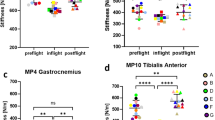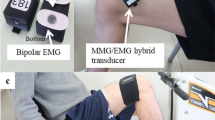Abstract
Physical exercise is important for people living under extreme environmental conditions to stay healthy. Particularly in space, exercise can partially counteract the loss of muscle mass and muscle strength caused by microgravity. Monitoring the adaptation of the musculoskeletal system to assess muscle quality and devise individual training programmes is highly desirable but is restricted by practical, technical and time constraints on board the International Space Station. This study aimed to test the feasibility of using myometric measurements to monitor the mechanical properties of skeletal muscles and tendons in weightlessness during parabolic flights. The mechanical properties (frequency, decrement, stiffness relaxation time and creep) of the m. gastrocnemius, m. erector spinae and Achilles tendon were assessed using the hand-held MyotonPRO device in 11 healthy participants (aged 47 ± 9 years) in normal gravity as well as in microgravity during two parabolic flight campaigns. Results showed significant (p < .05–.001) changes in all mechanical properties of both muscles and the Achilles tendon, indicating a more relaxed tissue state in microgravity. Recordings from a phantom rubber material with the device in a test rig confirmed that the device itself was not affected by gravity, as changes between gravity conditions that were too small (<1 %) to explain the changes observed in the tissues. It is concluded that myometric measurements are a feasible, easy-to-use and non-invasive approach to monitor muscle health in extreme conditions that prohibit many other methods. Real-time assessment of the quality of a muscle being exposed to the negative effect of microgravity and also the positive effects of muscular training could be achieved using Myoton technology.






Similar content being viewed by others
References
Agyapong-Badu S, Aird L, Bailey L, Mooney K, Mullix J, Warner M, Samuel D, Stokes M (2013) Interrater reliability of muscle tone, stiffness and elasticity measurements of rectus femoris and biceps brachii in healthy young and older males. Work Pap Health Sci 1(4):1–11
Aird L, Samuel D, Stokes M (2012) Quadriceps muscle tone, elasticity and stiffness in older males: reliability and symmetry using the MyotonPRO. Arch Gerontol Geriatr 55(2):e31–e39
Alibiglou L, Rymer WZ, Harvey RL, Mirbagheri MM (2008) The relation between Ashworth scores and neuromechanical measurements of spasticity following stroke. J Neuroeng Rehabil 5:18
Bizzini M, Mannion AF (2003) Reliability of a new, hand-held device for assessing skeletal muscle stiffness. Clin Biomech 18(5):459–461
Brashear A, Zafonte R, Corcoran M, Galvez-Jimenez N, Gracies JM, Gordon MF, McAfee A, Ruffing K, Thompson B, Williams M, Lee CH, Turkel C (2002) Inter- and intrarater reliability of the Ashworth Scale and the Disability Assessment Scale in patients with upper-limb poststroke spasticity. Arch Phys Med Rehabil 83(10):1349–1354
Chuang LL, Lin KC, Wu CY, Chang CW, Chen HC, Yin HP, Wang L (2013) Relative and absolute reliabilities of the myotonometric measurements of hemiparetic arms in patients with stroke. Arch Phys Med Rehabil 94(3):459–466
Dahmane R, Valeni V, Knez N, Eren I (2001), Evaluation of the ability to make non-invasive estimation of muscle contractile properties on the basis of the muscle belly response. Med Biol Eng Comput 39(1):51–55
Ditroilo M, Hunter AM, Haslam S, De Vito G (2011) The effectiveness of two novel techniques in establishing the mechanical and contractile responses of biceps femoris. Physiol Meas 32(8):1315–1326
Gopalakrishnan R, Genc KO, Rice AJ, Lee SM, Evans HJ, Maender CC, Ilaslan H, Cavanagh PR (2010) Muscle volume, strength, endurance, and exercise loads during 6-month missions in space. Aviat Space Environ Med 81(2):91–102
Korhonen RK, Vain A, Vanninen E, Viir R, Jurvelin JS (2005) Can mechanical myotonometry or electromyography be used for the prediction of intramuscular pressure? Physiol Meas 26(6):951–963
Liu J, Verheyden B, Beckers F, Aubert AE (2012) Haemodynamic adaptation during sudden gravity transitions. Eur J Appl Physiol 112(1):79–89. doi:10.1007/s00421-011-1956-6
Marusiak J, Jaskolska A, Budrewicz S, Koszewicz M, Jaskolski A (2011) Increased muscle belly and tendon stiffness in patients with Parkinson’s disease, as measured by myotonometry. Mov Disord 26(11):2119–2122
Marusiak J, Jaskolska A, Budrewicz S, Koszewicz M, Jaskolski A (2011) Increased muscle belly and tendon stiffness in patients with Parkinson’s disease, as measured by myotonometry. Mov Disord 26(11):2119–2122
Marusiak J, Jaskolska A, Koszewicz M, Budrewicz S, Jaskolski A (2012) Myometry revealed medication-induced decrease in resting skeletal muscle stiffness in Parkinson’s disease patients. Clin Biomech (Bristol, Avon) 27(6):632–635
Mullix J, Warner M, Stokes M (2012) Testing muscle tone and mechanical properties of rectus femoris and biceps femoris using a novel hand held MyotonPRO device: relative ratios and reliability. Work Pap Health Sci 1(1):1–8
Pandyan AD, Johnson GR, Price CI, Curless RH, Barnes MP, Rodgers H (1999) A review of the properties and limitations of the Ashworth and modified Ashworth Scales as measures of spasticity. Clin Rehabil 13(5):373–383
Peters A, Chase JG, Van Houten EE (2008) Digital image elasto-tomography: mechanical property estimation of silicone phantoms. Med Biol Eng Comput 46(3):205–212
Peters A, Chase JG, Van Houten EE (2009) Estimating elasticity in heterogeneous phantoms using digital image elasto-tomography. Med Biol Eng Comput 47(1):67–76
Ratsep T, Asser T (2011) Changes in viscoelastic properties of skeletal muscles induced by subthalamic stimulation in patients with Parkinson’s disease. Clin Biomech 26(2):213–217
Ratsep T, Asser T (2011) Changes in viscoelastic properties of skeletal muscles induced by subthalamic stimulation in patients with Parkinson’s disease. Clin Biomech (Bristol, Avon) 26(2):213–217
Roja Z, Kalkis V, Vain A, Kalkis H, Eglite M (2006) Assessment of skeletal muscle fatigue of road maintenance workers based on heart rate monitoring and myotonometry. J Occup Med Toxicol 1:20
Rydahl SJ, Brouwer BJ (2004) Ankle stiffness and tissue compliance in stroke survivors: a validation of Myotonometer measurements. Arch Phys Med Rehabil 85(10):1631–1637
Schneider S, Brummer V, Carnahan H, Kleinert J, Piacentini MF, Meeusen R, Struder HK (2010) Exercise as a countermeasure to psycho-physiological deconditioning during long-term confinement. Behav Brain Res 211(2):208–214
Schneider S, Kleinert J, Steinbacher A, Brümmer V, Strüder HK (2009) The effect of parabolic flight on perceived physical, motivational and psychological state in men and women: correlation with neuroendocrine stress parameters and electrocortical activity. Stress 12(4):336–349. doi:10.1080/10253890802499175
Vain A, Kums T (2002) Criteria for preventing overtraining of the musculoskeletal system of gymnasts. Biol Sport 19(4):1–17
Willmann M, Langlet C, Hainaut JP, Bolmont B (2012) The time course of autonomic parameters and muscle tension during recovery following a moderate cognitive stressor: dependency on trait anxiety level. Int J Psychophysiol 84(1):51–58
Acknowledgments
This work was supported by the programme “PLAN FOR EUROPEAN COOPERATING STATES” (PECS) signed between ESA and Estonia on 22 September 2010. We would like to thank the team at NOVESAPCE for their professional and friendly support during two parabolic flight campaigns. Vladimir Pletser from ESA is to be credited for his support during the preparation of the campaigns. We would also like to say thank you to all of our participants and operators during the 55th and 57th ESA parabolic flight campaign. Last and not least, we would like to thank BeOne (Hamburg), namely Folko Hülsebusch and Werner Tesch for their outstanding personal support. Merci.
Conflict of interest
One of the authors of this manuscript, namely Aleko Peipsi, is acting CEO of MYOTON AS, Estonia. There are no other conflict of interests.
Author information
Authors and Affiliations
Corresponding author
Rights and permissions
About this article
Cite this article
Schneider, S., Peipsi, A., Stokes, M. et al. Feasibility of monitoring muscle health in microgravity environments using Myoton technology. Med Biol Eng Comput 53, 57–66 (2015). https://doi.org/10.1007/s11517-014-1211-5
Received:
Accepted:
Published:
Issue Date:
DOI: https://doi.org/10.1007/s11517-014-1211-5




